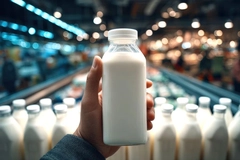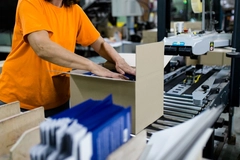Kellogg’s smartphone detectable cereal boxes championed as game-changer for blind consumer inclusivity

17 Aug 2021 --- Kellogg’s is permanently adapting all of its cereal boxes for blind and partially sighted consumers after a successful trial on Coco Pops boxes with UK supermarket Co-op. The inclusive cereal boxes are printed with coding technology enabling smartphones to detect and play back labeling and allergen information to users.
The NaviLens technology is reportedly similar to a QR code but can be detected in a fraction of the time from up to three meters away. NaviLens was initially created to provide navigational assistance, meaning it can help shoppers find a product and provide packaging information.
Kellogg’s trial partner, UK charity Royal National Institute of Blind People (RNIB), described the trial as “an overwhelming success,” with 97 percent of participants agreeing they would like to see more of these accessibility features available on grocery packaging.
After analyzing feedback, Kellogg’s and RNIB recognized the ability to access pack information digitally using NaviLens catered for the needs of everyone with sight loss, rather than just those with specific requirements, such as braille users.
Kellogg’s will integrate NaviLens technology on all of its cereal packaging beginning in 2022, with the first accessible boxes of Special K appearing on shelf in January.
Multi-purpose technology
Unlike other types of printed codes, NaviLens includes high contrasting colored squares on a black background. Users do not need to know exactly where the code is located to scan it.
The technology allows smartphones to pick up the on-pack code from up to three meters distance when a blind or partially sighted shopper points their device in the direction of the cereal box.
This then alerts the phone, and the shopper can choose to have the ingredients, allergen and recycling information read aloud to them, as well as reading it on their device using accessibility tools. Kellogg’s plans to integrate NaviLens technology on all of its cereal boxes in 2022, starting with Special K in January.
Kellogg’s plans to integrate NaviLens technology on all of its cereal boxes in 2022, starting with Special K in January.
The technology is currently used across Barcelona, Madrid and Murcia city’s transport systems, making the cities easier to navigate for thousands of visually impaired citizens.
Including the excluded
According to the UK National Health Service, over two million people in the UK live with sight loss and are unable to read the information on standard cereal boxes.
“As a company focused on equity, diversity and inclusion, we believe that everyone should be able to access important and useful information about the food that we sell,” notes Chris Silcock, head of Kellogg’s UK.
“I am proud that Kellogg’s will be the first company in the world to use NaviLens on packaging. We know it’s important all packaging is accessible for the blind community to enable them to make shopping easier, so we will share our experience with other brands who want to learn more.”
Javier Pita, NaviLens’ CEO, adds: “The incorporation of the NaviLens codes onto food packaging is a positive step toward a more inclusive and accessible shopping experience for the visually impaired. This allows people with sight loss to shop more independently and make their own food choices.”
“This announcement from Kellogg’s is a real game-changer within the packaging world,” continues Marc Powell, RNIB’s strategic accessibility lead. “It marks a significant step-change in how big brands can put accessibility at the forefront of design and packaging decisions and be a catalyst for change.”
Inclusive packaging designs
In similar moves, Unilever’s deodorant brand Degree has developed an antiperspirant for people with visual impairment and upper limb motor disabilities. The UK trial of Degree Inclusive was expected to commence this month.
In 2019, Kellogg’s Rice Krispies Treats partnered with Autism Speaks to create sensory “Love Notes” for children with autism to “express and receive love in their own unique way” during the school day.
In July, Germany-based Faller Packaging assisted start-up iuvas with the packaging design of its new sippa drinking aid for elderly and physically disabled people. Providing comfortable and safe help for those requiring drinking assistance, the sippa cup consists of many different components that have to be combined and inserted into one package.
PackagingInsights recently took a deep dive into cereal packaging with product design agencies Landor & Fitch and CreativeByDefinition Studio.
Edited by Joshua Poole











